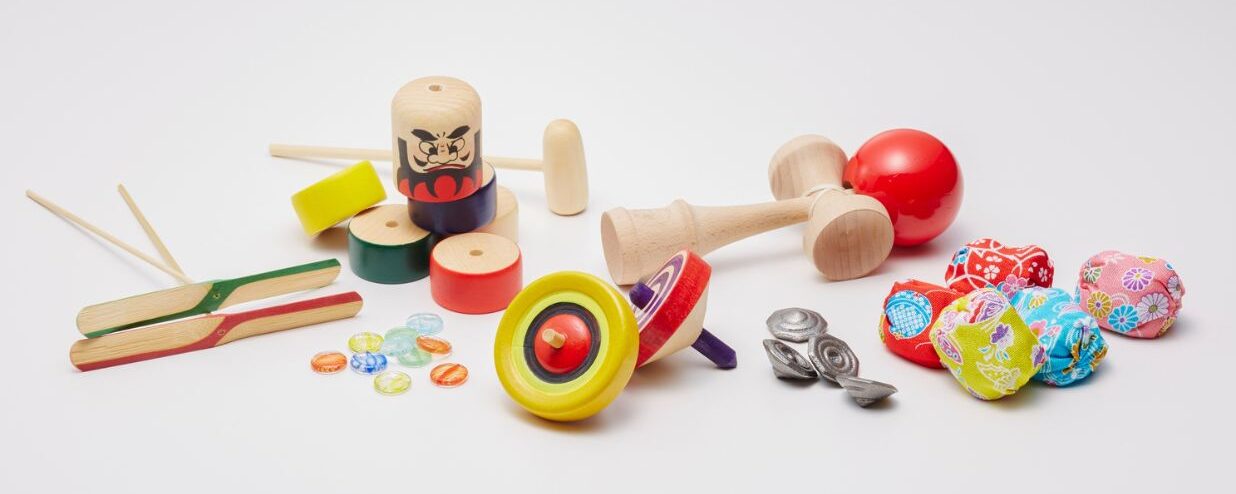Long before the anime craze, manga boom, or iconic games developed by Nintendo, Japanese people, like the rest of the world, enjoyed traditional games as a primary form of entertainment. Even today, when modern options abound, these traditional Japanese games hold a special, nostalgic place in many hearts.
These games are still very much alive in gatherings: cousins play them together during New Year gatherings, children enjoy kendama and hanetsuki in the summer, and friends assemble for rounds of karuta. After all, beyond mere amusement, traditional games have historically shaped social interactions and reinforced cultural values. They could even be a great icebreaker if you are trying to make new friends in Japan, when you want to step out of the usual Uno decks or Monopoly.
If you’re looking for entertainment beyond high-tech Japanese marvels, this blog post will explore traditional Japanese games that offer a fascinating glimpse into both Japan’s past and present.
History of Traditional Games in Japan
There is no single origin for traditional games in Japan. Many pastimes were introduced from other countries at different times and adapted to become uniquely Japanese, while others were created natively within Japan.
In general, Japanese games have roots going back centuries, often influenced by Chinese culture, religion, and local folklore. Many were designed not just for entertainment but also for education, strategy, and social bonding.
During the Heian period (794 – 1185), for example, games were often aristocratic and ritualistic. Court nobles enjoyed sophisticated board games like Sugoroku, a race game similar to backgammon.
Board and strategy games became prominent in medieval Japan. Shogi (Japanese chess), adapted from Indian chess via China around the 10th century, and Go (Igo), a territorial strategy game from China, emphasized long-term thinking and tactical skill. Sugoroku evolved into both strategic and story-based versions, while these games gradually became popular among commoners during the Edo period (1603–1868).
Children’s and physical games were also integral to Japanese culture. Games like Hanetsuki (shuttlecock game), Kendama (cup-and-ball), Beigoma (spinning tops), and Ohajiki (flicking coins) developed dexterity and social interaction. Seasonal and festival games, such as Takoage (kite flying) and Fukuwarai (blindfold face-pinning), were linked to New Year in Japan and other celebrations, blending play with ritual and communal enjoyment.
Many traditional games remain popular today, with some, like Shogi and Go, even having professional leagues. Toys such as Kendama and Beigoma continue to appear in festivals and cultural exhibitions, and are also easily available in stores like 100-yen shops such as Daiso.
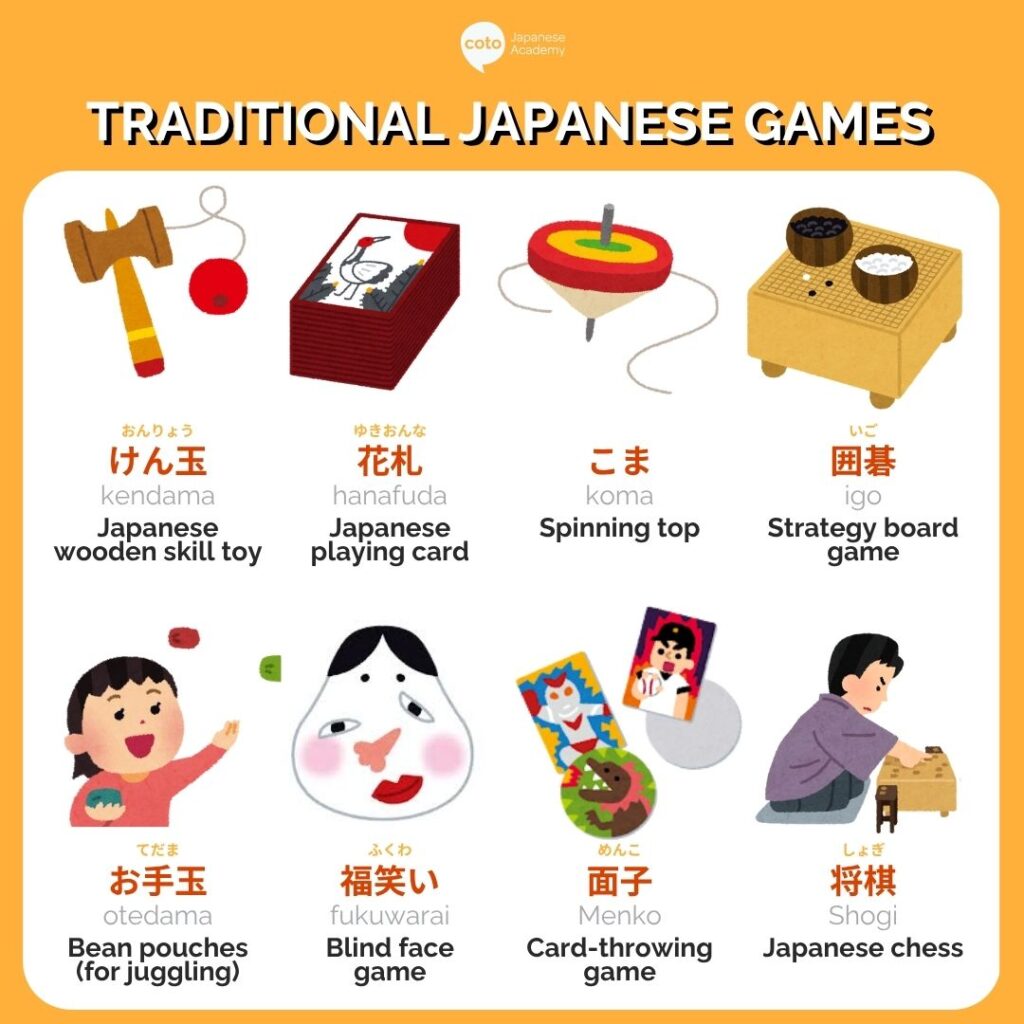
1. Kendama
The wooden toy kendama originated in France, passed through China, and arrived in Japan about 200 years ago. It consists of three main parts: a handle called the ken, a spike at the top, and a pair of cups on either side, all connected to a wooden ball called the tama by a string.
The goal of kendama is to perform tricks by catching the ball on the cups or spearing it with the spike. Simple techniques involve catching the ball on the larger or smaller cup, while advanced tricks include juggling, flipping, and combining multiple catches.
The concept seems simple, but kendama challenges hand-eye coordination, timing, focus, and dexterity. In modern Japan, there are even professional players performing complex tricks in tournaments. There is even a Japan Kendama Association
2. Hanafuda
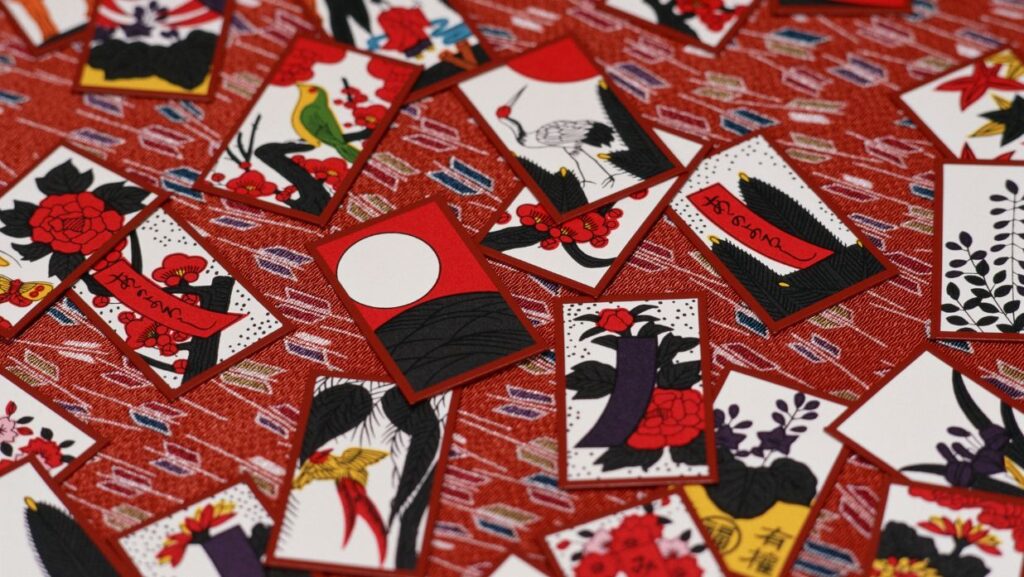
Hanafuda, also known as “flower cards,” is a traditional Japanese card game that dates back to the Heian period. Originally, the aristocratic elite didn’t play cards as we know them today but engaged in a game called mono-awase (ものあわせ, literally “object comparison”), where they judged the quality and uniqueness of collected items such as fans, paintings, and shells.
Modern hanafuda consists of 48 cards divided into 12 months of the Japanese calendar, with each month featuring a floral theme and seasonal symbols inspired by nature. The game is typically played by matching cards from a central layout to those in a player’s hand to form specific combinations, called yaku, which score points. Hanafuda requires a mix of strategy, memory, and luck, as players must decide which cards to keep, which to play, and how to block opponents from forming valuable sets.
3. Hanetsuki
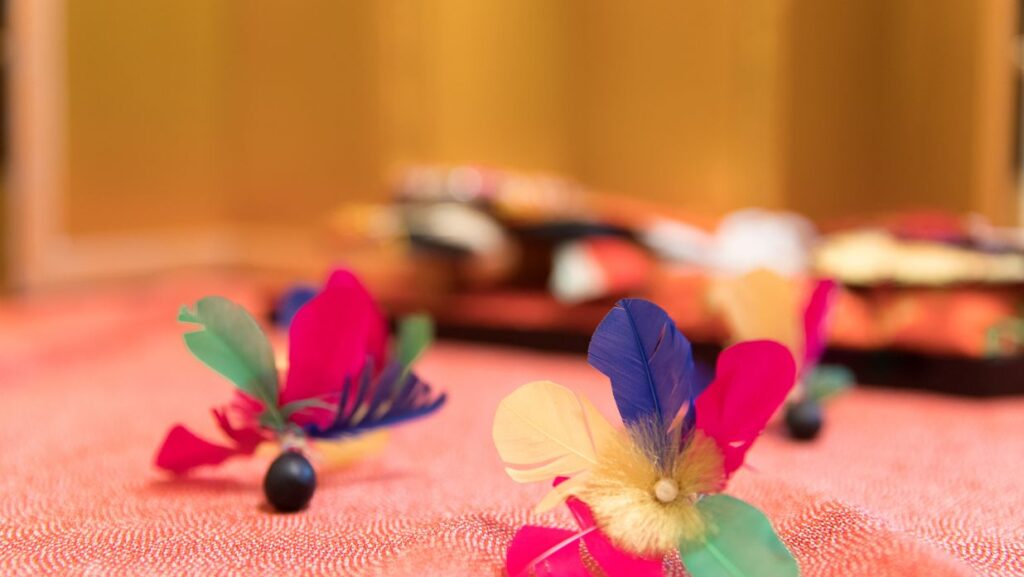
When most people think of racket sports, badminton and tennis usually come to mind. But in Japan, there’s a traditional game called hanetsuki that has been around for centuries.
Unlike modern rackets strung with nets, hanetsuki uses a decorated wooden paddle called a hagoita. Instead of a feathered shuttlecock, players hit a brightly colored object called a hane (a word that also means “wings” in Japanese). Back in the Muromachi period (1333–1568), it was part of exorcism ceremonies meant to ward off evil. Over time, it shifted into a playful New Year tradition, particularly popular among girls.
Hanetsuki can be played in two ways: either by one person trying to keep the shuttlecock in the air for as long as possible, or by two people rallying against each other until one misses. Traditionally, the player who fails to hit the shuttlecock is marked on the face with ink!
4. Koma
Koma are spinning tops and among the earliest traditional toys in Japan. They are believed to have come from China during the Heian period, but similar toys already existed in ancient Egypt around 1500 B.C. It is probably universal because the concept is simple: you set the toy in motion by winding a string around its base, a practice that allowed it to evolve into many forms, including whistling tops and competitive variants like Beigoma.
In Beigoma, players launch their tops into an arena, aiming to knock out their opponents’ tops, much like sumo wrestlers. The most popular way to play Koma is by competing to see whose top can spin the longest. Sounds familiar? This is because Koma also inspired modern adaptations such as Beyblade.
5. Igo
Go, or Igo (囲碁) in Japanese, is one of the world’s oldest board games, with origins dating back over 2,500 years to China. It is a two-player strategy game played on a grid-based board, where the goal is to surround more territory than your opponent and capture their stones. Despite its simple rules, Go requires deep strategic thinking.
The name Igo translates to “the game of encircling stones.” It became a favorite pastime among the aristocracy, samurai, and common people alike. By the 17th century, Go had gained professional recognition, with the first schools established to train expert players. Under the guidance of the Tokugawa Shogun, an official Go authority was also created.
Make sure not to think Igo is similar to chess. Unlike chess, which uses different pieces and focuses on capturing the king, Go uses identical stones for both players and emphasizes territorial control. The game has a dedicated following in Japan, Korea, and China, with professional players, schools, and competitions.
6. Shogi
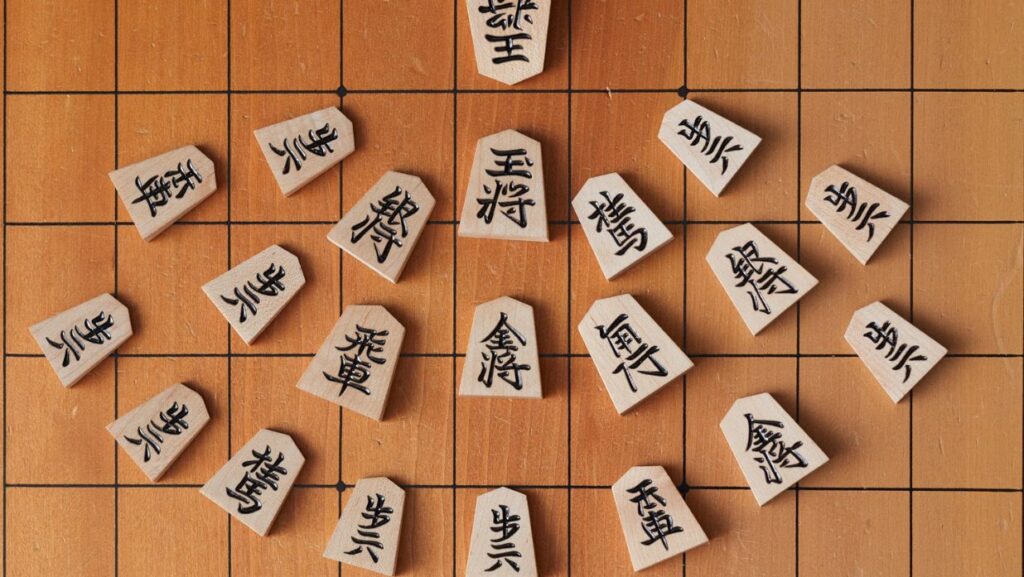
If we’re talking about Japanese chess, the closest equivalent would be shogi, which shares similarities with Western chess but also introduces unique elements. The game is played on a square grid, with the objective of capturing the opponent’s king. Unlike chess, captured pieces can be reused, adding depth and unpredictability to the gameplay. Shogi is one of the most popular board games in Japan and belongs to the same family of strategic games. The word Shogi literally means “general’s (将, shou) board game (棋, gi).”
Each player has a set of 20 flat, wedge-shaped pieces of slightly different sizes. Except for the kings, opposing pieces are undifferentiated by color, and each piece faces forward, with the pointed side oriented toward the opponent to show control. Pieces vary in importance, with the king being the largest and most important, down to the smallest. The biggest rule in shogi, and what makes it distinct from Western chess, is the “drop” rule, which allows captured pieces to be returned to the board under the capturing player’s control, creating dynamic and strategic gameplay.
7. Menko
Menko is a traditional Japanese card-flipping game, similar to the Korean game ddakji. Players use force to flip over their opponents’ cards, which are usually made of thick cardboard. Turns are often decided by rock-paper-scissors. On a player’s turn, all opponents place their menko on the ground, and the active player tries to flip one by throwing their own menko at it. If a card is successfully flipped, the thrower keeps it, and the owner of the flipped menko is out of the game. If no card flips, the next player takes their turn.
The game can be varied in several ways, such as drawing a circle on the ground where only menko knocked outside are taken, or taking turns with the first player to flip a card, claiming all on the ground. There is a bit of trick and strength to win, but also just a bit of luck.
8. Otedama
Otedama is a traditional Japanese juggling game using small, bean-filled pouches, historically made from fabric scraps and rice or azuki beans. The name translates to “puffs” or “beanbags,” and the game, often accompanied by songs, is similar to jacks or juggling.
The game can be played alone or in groups and has two main styles. Nagedama is like Western juggling, where the player tosses the beanbags in a shower pattern, often while singing a nursery rhyme. Yosedama, the more popular style, involves spreading five beanbags on the ground, tossing one into the air, and catching another from the ground with the same hand, repeating the process until all five are caught before starting again.
9. Daruma Otoshi
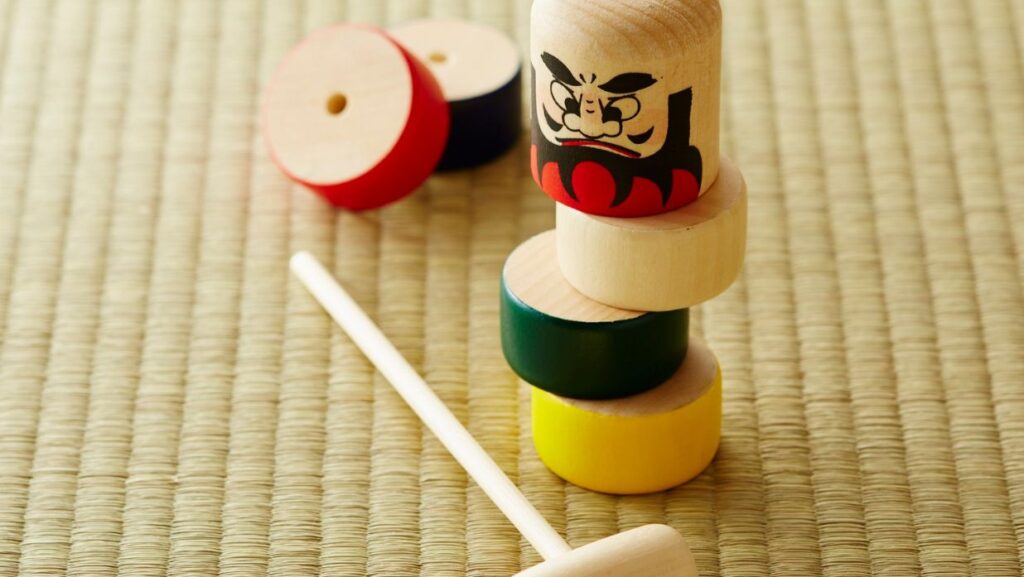
Daruma is a hollow, round Japanese papier-mache doll modeled after Bodhidharma, the founder of Zen Buddhism, while the word otoshi means “to fall” in Japanese. Together, daruma otoshi is a traditional Japanese game of colorful blocks topped by a daruma doll.
The rule of the game is straightforward: players use a hammer to knock out wooden blocks from bottom to top while maintaining balance. The relatively newish traditional Japanese game, born in the Edo period, also carries symbolic meaning as a good luck charm, often appearing during New Year celebrations and festive occasions. Traditional daruma otoshi is made with simple wooden, cylindrical blocks, but modern iterations include versions featuring popular characters and playful designs. Some use anime characters or animal-shaped blocks.
10. Fukuwarai
While other traditional Japanese games challenge your strength, coordination, and even strategic thinking skills, Fukuwarai challenges expression! Fukuwarai, which literally means “lucky laugh,” in Japanese, is a popular children’s game during New Year’s celebrations.
Players are seated at a table with a paper drawing of a human face with no features, along with cutouts of facial features such as the eyes, eyebrows, nose, and mouth. It commonly uses an Okame-style face of a woman with large cheeks, or a Hyottoko, a man with a silly expression, and his mouth sticking out. Blindfolded, the players attempt to place the features in the correct positions. This is why 100% correct placement is often due to sheer luck, hence the name.
11. Kemari
Kemari is a traditional Japanese ball game that was introduced from China during the Yamato period, around 1,400 years ago. The game has no winners or losers. Its main goal is simply to keep the ball in play by passing it among players without letting it touch the ground.
Historically, kemari was popular among court nobles and was often played in the Imperial Palace, with records of the game appearing in texts from the mid-Heian period. The game, which resembles hacky sack, emphasizes teamwork, coordination, and graceful movement.
Today, kemari is mainly performed as a ceremonial sport, but its cultural significance and unique style are still celebrated during traditional festivals. Modern players wear uniforms reminiscent of Heian-period attire, including a crow hat. This type of clothing, called kariginu, was fashionable during that era.
12. Ohajiki
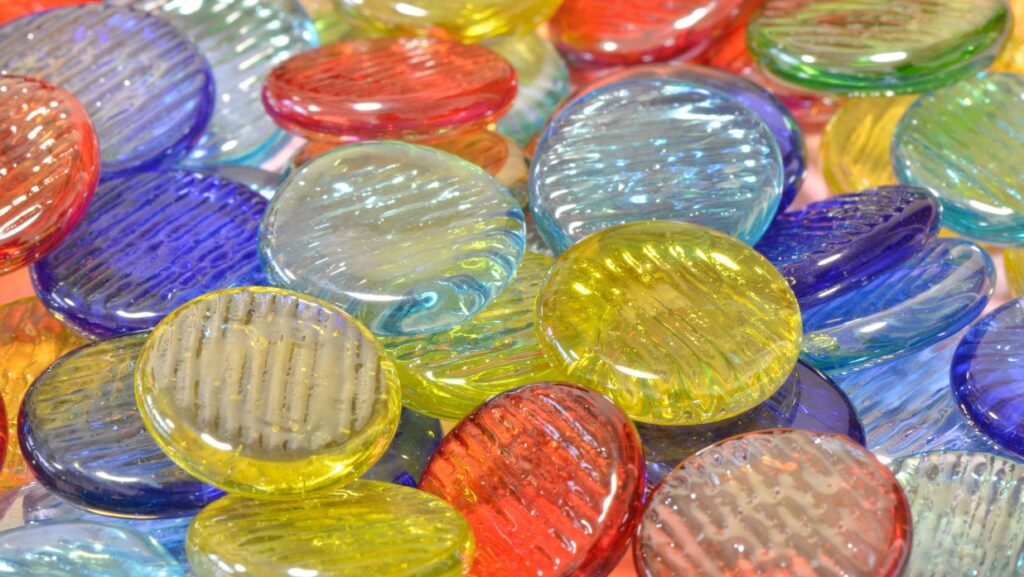
Ohajiki (おはじき) is a traditional Japanese game, similar to marbles, played with small, flat, coin-shaped pieces called ohajiki. In the past, players used pebbles, seashells, or even Go stones, but today the pieces are usually made of glass or plastic. Players take turns flicking their pieces with their fingers, aiming to hit other pieces. To play, a circle is made with the thumb and index (or middle) finger, and one piece is flicked with the thumb.
13. Shiritori
Shiritori (しりとり) is a popular Japanese word game, similar to the English game of word chain. Players take turns saying a word that begins with the last syllable (kana) of the previous word, rather than the last letter, since Japanese is written with syllables instead of individual letters. Shiritori is not only fun but also a useful way to learn Japanese or reinforce vocabulary. There are even online versions of the game that allow players to practice anytime.
14. Renju
Renju is a professional variant of the abstract strategy board game Gomoku. It was named by Japanese journalist Ruikou Kuroiwa on December 6, 1899, in the newspaper Yorozu Chouhou. The name “renju” means “connected pearls” in Japanese.
Renju is played on a 15×15 grid, where two players take turns placing black and white stones. The goal is to be the first to make a line of exactly five stones in a row: horizontally, vertically, or diagonally. The person with black stones has to be extra careful because some moves are not allowed, like making two lines of three or four at the same time, or more than five in a row. The white player can play without these rules.
Players focus on creating chances to win while blocking their opponent. The simple rules allow for creative strategies, which is why Renju is played competitively in countries like Japan, China, and Russia.
15. Daifugo
Have you ever played President? You might be surprised to learn that it actually originated in Japan, where it’s called Daifugo. Like the President, Daifugo has many house rules, but the core rules are simple: all cards are dealt evenly, and then the Daifugo gives their two worst cards to the Daihinmin (Grand Pauper), who, in return, gives their two best cards to the Daifugo. The game is generally played clockwise.
Players are ranked from highest to lowest. The Daifugo, or Grand Millionaire, is at the top, followed by the Fugo, or Millionaire. In the middle is the Heimin, or Commoner, then the Hinmin, or Pauper, and finally the Daihinmin, or Grand Pauper, at the bottom. Players who aren’t in the top or bottom two are considered Heimin, though more ranks can be added for larger groups. In some versions, players change seats according to their ranks, though this is less common in Western adaptations. In the first round, everyone starts as Heimin.
Daifugo is a trick-taking game where the goal is to get rid of your cards as quickly as possible. The first person to do so becomes Daifugo for the next round, the second becomes Fugo, and the last player becomes Daihinmin. The Daihinmin then gathers the cards, shuffles, and deals for the next round.
Want to Learn Japanese Through Games?
Have you ever encountered traditional Japanese games like Daifugo or Renju? Playing these games is one of the most fun ways to immerse yourself in Japanese culture, and if you want to go even further, why not try playing in Japanese?
At Coto Academy, a premier Japanese language school in Tokyo and Yokohama, you can learn to speak and have fun in Japanese while exploring culture. Our classes focus on practical Japanese for conversation, and we offer both intensive and part-time lessons to fit every schedule. Even beginners can start speaking from day one, thanks to our hands-on approach.
Why join Coto Academy?
- Professional, native Japanese teachers
- Over 60 different classes across 18 levels
- Small classrooms with up to 8 students for personalized support
Fill out the form below for a free level check and consultation, and start your journey learning Japanese through culture and conversation!
FAQ
What is the oldest game in Japan?
A common Japanese game is Shogi, often called Japanese chess, which is widely played across Japan and remains a favorite traditional board game.
What is the oldest game in Japan?
Sugoroku, a board game dating back to the Heian period (8th–12th century), is considered one of Japan’s oldest games.
What is the traditional Japanese game for kids?
For children, traditional Japanese games like Kendama, a skill toy, and Otedama, a beanbag juggling game, have been popular for generations and are still enjoyed today.
What is the main game in Japan?
While multiple games are popular, Shogi and Go are considered the main traditional games played nationwide.
Want to learn other ways the Japanese keep themselves entertained, or want to read more entertaining content instead? Check out:
